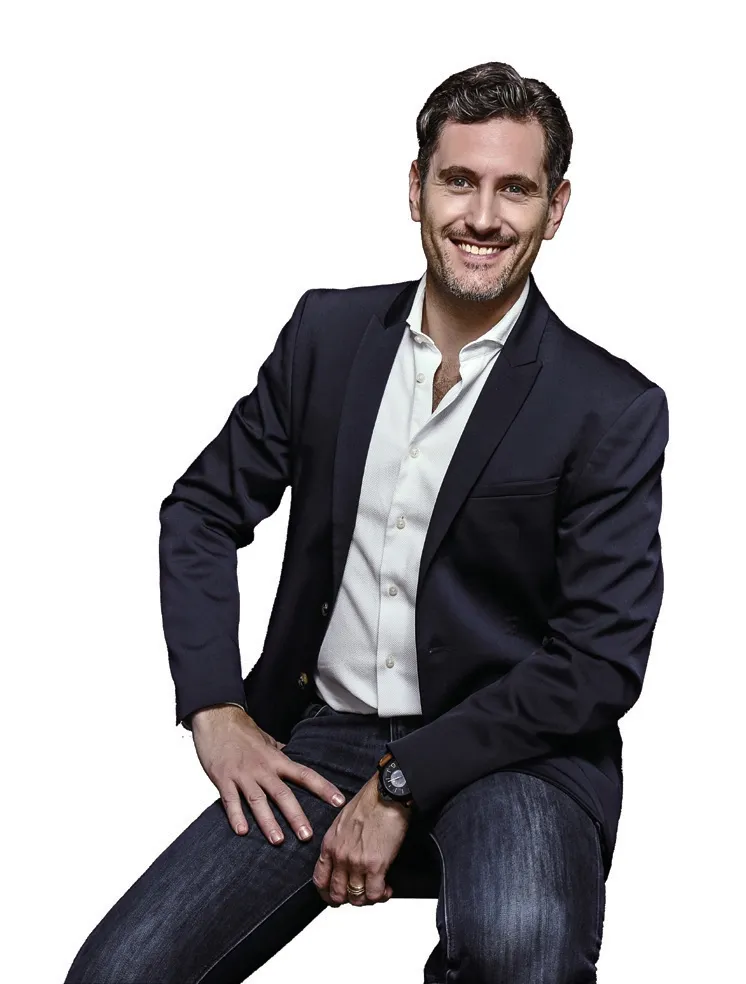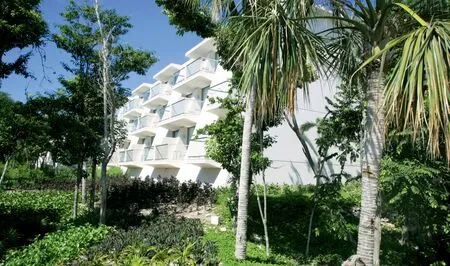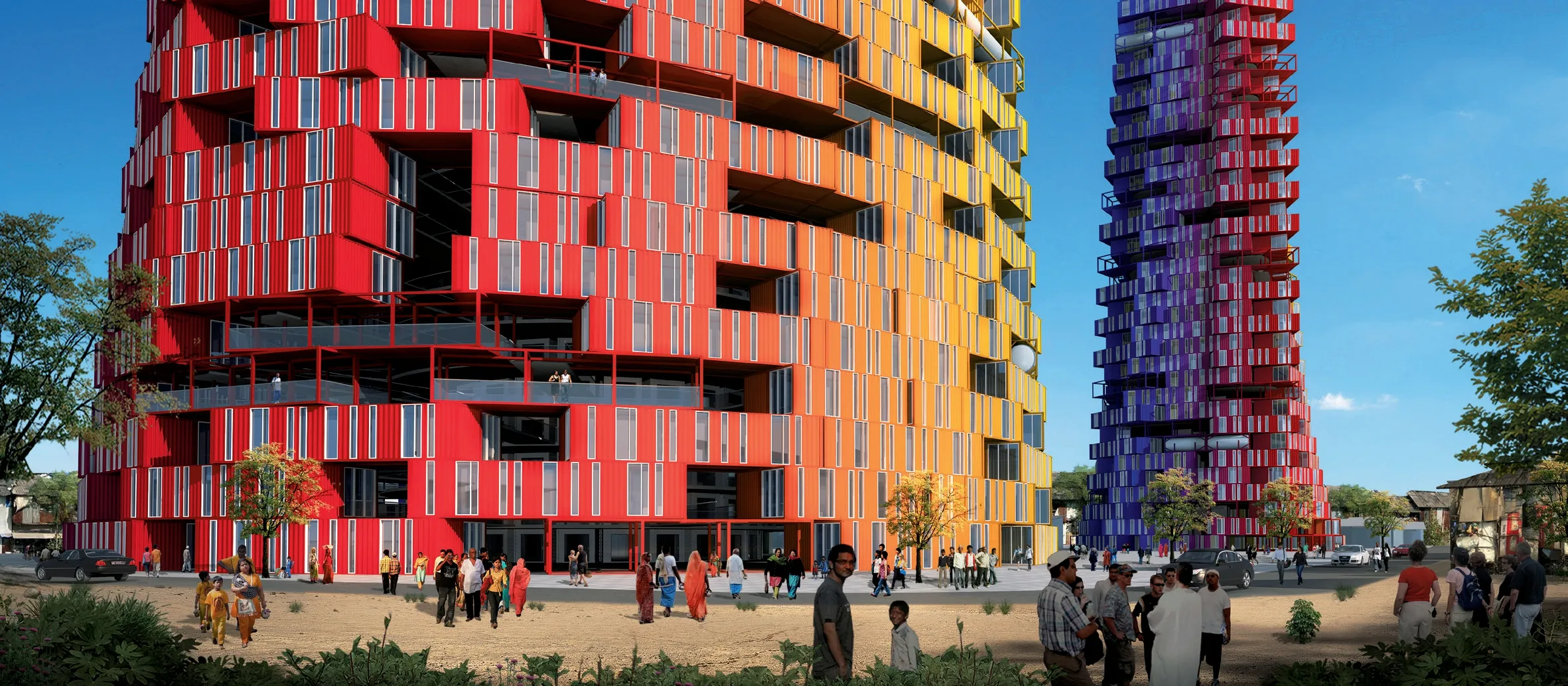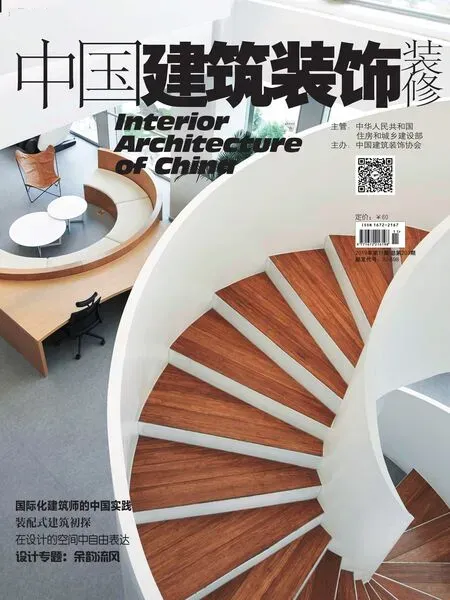国际化建筑师的中国实践
本刊记者 符媛

Carlos Gomez 卡洛斯
西班牙CRG 建筑设计咨询有限公司创始人、合伙人兼董事
COAC—国际合作伙伴AIA
卡洛斯在巴塞罗那的加泰罗尼亚理工大学高级建筑技术学院建筑艺术系取得了硕士学位。2010 年,他又于 Elisava 设计学院获得了高级建筑和数字设计进修硕士学位, 专注于新数字模式对设计过程的影响。在超过 20 年的时间里,他一直都在国际知名公司担任建筑设计师以及项目总监,并参与了世界各地的多个项目。2010 年卡洛斯在巴塞罗那创建了自己的西班牙CRG 建筑设计咨询有限公司。目前,他也开始了在中国地区的多个项目。他用新鲜的建筑理念创造了新的建筑浪潮。
《中装》:您在西班牙事业进展不错,为什么选择在中国开始了新尝试。在国外和中国工作有哪些明显不同?
卡洛斯:首先,您说我在西班牙有不错的职业起点,其实现实情况与您所想大不相同。许多中国人都认为或相信,只要出生在西方国家,生活问题就能够自行解决。现实与此大相径庭。在西方国家的就职状况和在中国是一样的,甚至更不乐观。这段故事可以在以后的采访中再讲。
之所以选择在中国重新开始,是因为2008 年灾难性的经济危机席卷了欧洲和西方世界,直到2019 年的今天,这一危机仍未完全克服。19 世纪和20 世纪,未来和繁荣都寄托在了欧洲和美国。而在21 世纪,繁荣的未来将会出现在亚洲。
在我目前的职业生涯中,我在8 个不同的国家工作过。他们的语言、文化和社会经济状况都各有不同。在中国和西方国家拓展工作有太多、太大的差异,对此如果将来有可能的话,我甚至可以写一本书。目前,我无法下断言说那些差异是好是坏,它们都是基于自己周围的环境和现实,都有其特色和特殊性。当然在中国工作一直、直到现在都是我一生中最复杂但又最丰富的经历。
《中装》:您具备优秀建筑师的哪些特点?您一直供职于国际知名事务所和公司,也在高校担任教授,理论知识与实践经验都很丰富。您认为哪方面对您来说受益最大,原因是什么?
卡洛斯:其实我认为不存在评判一个建筑师好或不好的基本规则,存在的是通过不断学习获得的知识多少。那些相信自己在大学毕业后就已经成为建筑师的人对自我是盲目的,而盲目的自我本身就是建筑师最大的敌人。建筑师的道路从他第一次踏入建筑学校那天开始,直到死亡才会停止。无论是充满成功亦或是充满错误的职业生涯,持续学习都是最基本的工具。在世界知名的事务所工作也好,在大学担任教授也好,我们始终都必须从我们遇到的所有人或事中学习知识,以及最重要的——自我批评。它是我们作为建筑师持续提升技能的基础。尽管有时知识也来自于日常生活,很多情况下,我们还要从同事和建筑师朋友身上学习。就我个人而言,最令我最受益匪浅的正是如今正在缺失的两样东西——有关建筑的历史和对有见地的批判性文字的阅读。这两个基本要素能够帮助了解我们留下了什么,并为我们提供关于未来的线索。

集装箱摩天大楼 STEEL CITY CONTAINER SKYSCRAPER
《中装》:您拥有丰富的国际工作经历。请问您是如何将西方工作方式和多元化视角融入到中国的实践中的?
卡洛斯:在西方和在中国都有多种多样的工作形式。我曾在深圳和北京,一南一北两个城市工作过,这两个地方都有自己的特点和不同的工作方式。就业务方面而言,在西方国家启动项目很多情况下都仅仅是在专业领域内。与客户的个人关系是在项目结束时或工作之中建立的。在中国,情况则截然相反。在不认识客户也没有与客户建立亲密关系时就接触项目,取得客户信任,获得项目的订单,这种情况极少出现。从这个角度来看,在中国获得一个项目比在西方国家需要更多的前期时间,因为在建立关系和个人交往上要做许多工作。就项目本身而言,在某些情况下,客户一开始会偏爱西方的工作方式,尽管在项目进展中他们逐渐表明希望采用本地做法。因而你必须可以足够灵活地适应这些要求。
几年前西方工作方式在中国环境下实践的视角比现今要多得多。目前,在经过中国经济的长期发展之后,客户也已经增长了不少这方面的认识。现在他们提出,工作方式需要将国际内涵适用于当地特点,这个要求比之前的更高了。这可以用著名的短语“全球化思考,本地行动”来概括。

集装箱摩天大楼 STEEL CITY CONTAINER SKYSCRAPER

商人中国外运集团 MERCHANTS MIXED USE COMPLEX

宝能购物中心及酒店 BAONENG SHOPPING MALL & HOTEL
《中装》:建筑师是个需要大量努力和技术的专业职业。您认为成为建筑师是否有捷径可走?
卡洛斯:的确,建筑师的路途艰辛,需要掌握许多艺术和技术知识。尽管有时会出现很有天赋的建筑人才在一众专业人群中脱颖而出,但一个年轻且经验很少的人获得国际建筑奖并不常见。成为一个真正的建筑师或是一个合格的专业人士没有捷径可走。重要的是经验、不断地学习以及对这个美丽而艰苦的职业的热情奉献。
《中装》:2005 年的集装箱摩天大楼当年备受关注,报道不断。您能介绍更多的信息吗?
卡洛斯:用海运集装箱建造的摩天大楼是我们在国际上最受好评的项目之一。它已被翻译成25 种以上的不同语言,在30 多个国家和地区展示刊登,这足以说明它从建筑风格上来说对公众的吸引力。它获得了国际上如此广泛的关注,不仅仅因为它颇具创作力的美感,可能也因它在某种程度上有些激进的外形,也由于它拥有足以引起社会争议的特点。至今为止,还没有人能够为保障性社会住房提供摩天大楼形式的方案。我们提出并获得了几乎全球的关注。这个项目我认为从概念上到形式上都非常漂亮。鉴于在当今社会,经济上处于最弱势的人群有太多进行自我建设的需要,借用集装箱这种方式可以运用在许多地方,它可以让许多贫困家庭生活质量得到提升。
《中装》:CRG 的团队合作是什么形式的?团队有什么特点和优势?
卡洛斯:CRG 的最大优势在于人与人之间的友谊,它将我们团结在一起,建立起彼此间的信任。这并非一朝一夕就能获得,而是随着时间的流逝,在并肩工作、共同经历困难的处境和解决复杂的问题中结成的。所有人从中都自得其乐,因为从根本上来看,如果你在工作中没有享受到乐趣,那么也几乎不会将对建筑的热情传递给你的合作者。

创新工业服务中心 INNOVATIVE INDUSTRY SERVICE CENTER

圣恩尼斯五星级度假酒店 GRAND SIRENIS RIVIERA MAYA* 5 RESORT&SPA

竹之城 ARCHITECT’S VILLAGE BAMBOO SKYSCRAPER
《中装》:有人说可持续性、手工制作、材料可能是不远未来建筑的三大特性。您是否认同?您认为未来建筑的走向是怎样的?
卡洛斯:可持续发展已不再是未来。它是且必须是建筑的当下之词。如果我们不把可持续建筑作为建筑物的首要目标,那么几年之内我们将没有再建的地方了。
伟大的建筑师高迪,来自我的故乡巴塞罗那,他是大量且出色地将工匠运用到建造中的最后一人。“手工制作”一词目前从建筑上来看就是个乌托邦。建筑中的工匠技艺在很多年前就已经被市场经济所淹没。用工匠的方法并不能有效地建造,必须使用预制和机械化施工的工业方法(例如3D 打印建筑物)高效、可持续地进行建造。
建筑材料可能是建筑领域尚未企及的革命之一。人们不断看到技术行业对材料的改进、创新和发明,例如石墨烯的应用。这些创新迟早会应用于建筑,彻底改变我们的建造方式和建筑形状。
对建筑的长期趋势很难预测,因为它们在许多情况下是对社会行为模式、经济革命或科学发现的反应。今天,我们生活在经济和社会层面上最不稳定的时期之一,而相对地,我们也生活在人类历史上最快、最密集的城市增长过程之中。所有这些,都反应在建筑师正在构建的建筑上,反应在实际社会所需要的建筑上。
《中装》:本土化是建筑师所要考虑的重要因素。您在项目中很好地尊重了建筑周边的环境。您认为您的哪个作品考虑了较多的当地性,也运用得较好?
卡洛斯:实现一个好的概念,并以高效和可持续的方式进行构建,了解项目所在地至关重要。在我们的研究中,我们总是尽可能地尊重近处环境和远处环境,当然环境也包括人为构造的影响。请记住自从人类受孕以来,第一个栖息地就是母亲的身体。那是一个可变的、可持续的、灵活的、温暖的乡土栖息地,没有边缘、没有直线,完全可塑且具有动感柔和的形状。那应该是人类建筑未来的目标。当前,参数计算的使用变得越来越广泛。与用传统构想方式并手动创建或绘制相比,参数计算更为高效快捷。参数化建筑(如果可能的话)使项目的位置变得更加重要,它为我们提供了更快的速度和更多的信息,从而能够为使用者带来性能和服务功能更强的高质量的项目。我们的作品中,在参数化方面做过的最好的其中之一,是国际上最受赞誉的项目——在新加坡以竹子结构制成的城市栖息地——也刊登在全球无数的建筑方面出版物上。

集装箱摩天大楼 STEEL CITY CONTAINER SKYSCRAPER
《中装》:习近平主席在一次会议中提出,不要搞奇奇怪怪的建筑。您认为怎样区分奇奇怪怪的建筑和富有想象力的建筑?您怎样评价中国的建筑和中国的设计师?
卡洛斯:我清楚地记得第一次听到这一讲话的那天,习近平主席谈到了希望中国城市中不要再出现任何古怪的建筑。事实是,在中国的这些年,我见到了中国最近几十年来所建的建筑,发现其实外国建筑师和中国建筑师都有这种弊端,就是他们总是想做一些与众不同的事情。我见到过直接取形于“白酒”瓶的建筑,或者是诸如乌龟样子的旅馆以及蟹形房屋。这些都是奇怪的建筑的代表,以至于对这些建筑的评论和抱怨快要盖过中国作为国际建筑界重要组成部分的成就。但实际上,中国所谓极具想象力的建筑物(不是上面提到的那些怪异的畸变)在国际上享有盛名的也不少,比如坐落在北京的央视大楼、奥林匹克体育场(鸟巢)、新建的大兴机场等。在我看来,这些项目都是高质量且富有想象力建筑的典范,在概念上具有高度的连贯性,而不是前面提到的那些建筑畸变。充分理解习主席的讲话后,我认为,在过去的几年中,大家都像是普遍得了健忘症一般,为了获得更高速的经济发展,忽略、忘记了中国在过去的主导地位,以及曾有过的高度的文化繁荣。现在已经到了发展的紧迫点,反思过去,重拾古代先贤思想和中国文化身份,并将其转变为中国新设计浪潮的时候到了。这就是习近平主席所说的目标,而我的许多中国建筑师朋友也正为此努力。
《中装》:您近期有什么计划?最近正在进行中的项目有哪些?中国市场是否是主攻目标?

润方生物总部 REDPHARM HEADQUARTER
卡洛斯:最近,中国高速发展的建筑市场正在放缓,甚至还有整体停滞的感觉。与美国的贸易战影响到了公司和投资者。鉴于市场的不确定性,他们宁愿等待观望、慎重投资。这就是为什么我们最近根据市场趋势开展了多个室内设计项目,而不仅仅是建筑类的。本月,我们刚刚完成了我们室内设计最重要的项目之一——对北京一个室内办公空间进行整体翻新和重新设计。我们目前正在进行的项目,有一个西安的火车站,一个新的革命性的机场概念的竞赛,还有在沿海地区为各种非洲社区设计的漂浮房屋等等。与此同时,最后一个问题的答案也呼之欲出。如您所见,我们并不以地方主义的方式理解建筑。对于我们来说,地球就是我们的家。因此,我们不仅在一个国家中寻找项目,而且还要在包括中国在内的多个国家同时寻找项目。

THE PRACTICE OF AN INTERNATIONAL ARCHITECT IN CHINA
Q&A
IAC:You had a good start in your career in your country. Why did you choose China to set up a new beginning? What are the obvious differences between working abroad and working in China?
Carlos:Well, first of all, it is a surprise that you tell me that I had a good career start in my country, because the reality is very different. Many people in China think or believe that by the simple fact of being born in a western country you already have your life solved, and nothing is further from reality. Professional life in the western countries is the same or sometimes even more difficult than in China. But we'll leave that story for another interview. The reason I chose China to start a new beginning was the disastrous economic crisis that hit Europe and the Western world in 2008, which still today in 2019 has not been completely overcome. During the nineteenth and twentieth centuries, the future and prosperity were in Europe and the US. During the 21st century, the place where the prosperous future will be found is Asia.
Throughout my career I have been able to work in 8 different countries, with different languages, different cultures and different social and economic realities. The differences between developing my profession in China or in western countries are so many that I could write a book about it. Someday I may write it. At the moment I will only say that not all differences are good or bad, but that each one of them has its peculiarity and its specificity, depending on the environment and the realities that surround them. And working in China, of course, has been and is, the most complicated but in turn the most enriching experience of my life.
IAC:What characteristics do you have to become an excellent architect. As we know, you have been serving world-renowned architecture offices and acting as a professor in college for years, with a good mastery of both theories and practices. Which part do you think benefits you the most and why?
Carlos:There is no basic established rule to be a good or a bad architect. What does exist is knowledge through continuous learning. Those who believe they are already architects when they have finished college are blind of ego, and the self-ego is the worst enemy of an architect. An architect's path begins the day he sets foot in the architecture school for the first time, and ends the day he ceases to be in this world. Continuous learning is the basic tool for a career full of success, but also for a career full of mistakes. We must always try to learn from any situation or person that we find in our way, whether we are working in world-renowned architecture office or being professors in the university, knowledge and, above all, self-criticism, are the basis of the continuous improvement of our skills as architects. On many occasions we also learn from our colleagues and architect friends, although sometimes that knowledge also comes from the situations in which we find ourselves in everyday life. Personally, the two things that benefit me the most, are something that is being lost today, the reading of a good critical text, and the history of architecture. Two essential elements to know what we left behind and give us clues about what lies ahead.
IAC:With your international working experience, how do you incorporate western way of working and multiple perspectives into your practice in China?
Carlos:There are many forms of Western work and many forms of work in China. I have lived and worked in Shenzhen and in Beijing, North and South of China, and both places have their own characteristics and different ways of working. As far as the business side is concerned, the way to start a project in the Western world is on many occasions something purely professional, establishing personal relationships with clients at the end of the project or at the end of its construction. In China it is totally the other way around. On very rare occasions you can start a project without having known and established a personal relationship of friendship with the client, to gain their trust and thus receive the order of the project. From that point of view, achieving a project in China requires much more previous time than in Western countries, since much effort must be invested in building those relationships and personal contacts. When talking about the project itself, on some occasions the clients prefer the Western way of working at the beginning, although during the development of the project they gradually suggest that they prefer the local way of working, and you must be able to be flexible enough to adapt to those requirements. The perspectives of the practice of the Western way of working in China some years ago were much more numerous than today. Currently, customers have already learned a lot after the long years of economic development in China, and now they are much more demanding than before, asking that the way of working had international connotations adapted to local peculiarities. This is summed up in the famous phrase "think globally, act locally".
IAC: Architect is a profession with a lot of hard work and professional skills in it. In your opinion, what it takes to be a qualified architect and is there a shortcut to be a real architect?
Carlos:It is very true that the path of an architect is arduous and that you need to have a lot of knowledge, both artistic and technical, and although sometimes there are natural talents for architecture that stand out from the great mass of professionals, it is not very common that someone who is so young and with so little experience stands out receiving an international architecture award. There is no shortcut to be a true architect, or a good qualified professional. Here what counts is the experience, the continuous learning, and the dedication with passion to this beautiful but hard profession.
IAC:Steel City Container Skyscraper won a great deal of attention in 2015, as we have found a series of reports concerned with it. Can you tell us more about it?
Carlos:The skyscraper made with shipping containers is one of our most internationally acclaimed projects. It has been published in more than 30 countries and translated the text into more than 25 different languages, which speaks for itself of its own attraction to the public architecturally speaking. It has probably gained so much international attention not only for its creative aesthetics and perhaps somewhat aggressive shape, but also for its socially controversial character. Until today nobody had been able to propose protected social housing in the form of a skyscraper. We did it and we got the attention of almost the entire planet. It is a project that I think is very beautiful, both conceptually and formally, which could be implemented in many of the places where today the self-constructions of the most economically disadvantaged people in our society are piled up, and that could improve the quality of life of many families in a situation of poverty.
IAC:What is it like of the teamwork in CRG? What are the features and advantages of CRG?
Carlos:The greatest advantage of CRG Architects is the friendship that unites us, the trust we have with each other, which is not earned in a single day, but is forged over time, working side by side, going through difficult situations and solving complex questions, all together always trying to have fun, because ultimately, if you do not have fun working in your profession, you will hardly transmit that feeling of passion for architecture to your collaborators.
IAC: It is said that sustainability, craft, materials are the three key words marking the feature of the architecture in near future. Do you think so? How will you tell the trends of future architecture?
Carlos:Sustainability is no longer a word of the future. It is, and must be, a word of the present in architecture. If we do not think our buildings with the first target of being sustainable constructions, we will not have any planet where we can build in a few years. The last great architect who made use of artisans in a massive and great way was Gaudi, in my hometown, Barcelona. The word “craft” is currently a utopia. The craft in architecture is already many years ago overwhelmed by the market economy. It cannot be built efficiently with artisan methods. It must be built efficiently and sustainably, with industrial methods of prefabrication and mechanized construction, such as 3D printed buildings. The construction materials probably are one of the revolutions that are yet to reach the architecture. Improvements, innovations and inventions in materials used by technology industries are constantly being seen, such as graphene, and sooner or later these innovations will be applied to architecture, revolutionizing the way that we build and the shape of our buildings. Long-term trends in architecture are difficult to guess, since they respond in many occasions to social behavior patterns, economic revolutions, or scientific discoveries. Today we live in one of the most unstable periods in history, economically and socially, and in turn we are living the fastest and most dense urban growth in the mankind history. All of this is having a reflection on the architecture that we the architects are producing, and the architecture that the actual society demands.
IAC:Locality is an important factor for architects to consider. In your projects, we find that you gave a good respect to the environment around it. In which work have you considered localization the most and used it the best?
Carlos:Understanding the location of projects is essential to be able to realize a good concept, and to be built with efficiency and sustainability. In our study we always try to have the utmost respect for both the immediate environment and the distant environment, which is also affected by the artificial constructions of man. Remember that the first habitat of man since it is conceived is the body of the mother. It is a transformable, sustainable, flexible, warm and vernacular habitat, without edges, without straight lines, fully malleable and with dynamic and soft shapes. That should be the goal of the future of man's constructions. At present, the use of parametric calculations is becoming increasingly extensive, which can be made and created in a much more efficient and faster way than the human hand when creating or drawing projects conceived in a traditional way. The parameterization of the architecture has allowed the location of the projects to be more important even if possible, since it has provided us with greater speed and a greater amount of information to be able to carry out a better-quality project with better performance and service functions for its users. In our case, one of our best examples in parametricism was another of the most acclaimed projects internationally, an urban habitat made with bamboo structure in Singapore, also appeared in countless architecture publications worldwide.
IAC:Our General Secretary Xi Jinping proposed once in a meeting that we should not build strange buildings. How will you tell a strange building and an imaginative building? What is your opinion and evaluation on Chinese buildings and architects?
Carlos:I do remember perfectly the day when we all heard that speech for the first time, in which President Xi talked about the nonacceptance of any weird buildings in Chinese cities. The truth, and after these years of experience in China, seeing what has been built in recent decades, there has been an abuse, both by foreign architects and by Chinese architects, in the fact that they always want to do something different. I have seen examples of buildings literally transformed into “baijiou” bottles, or animals such as a turtle-shaped hotel, or a crabshaped house. These are examples of strange buildings that have covered the comments and complaints of a good part of the international architectural community regarding what is happening in China. On the other hand, there are the so-called imaginative buildings (not weird aberrations such as those mentioned above), as one of the best-known examples internationally, the CCTV building, the Olympic stadium (Bird's Nest), or the new Daxing Airport, both three in Beijing. In my opinion those projects are a great example of quality imaginative architecture and with a great coherence with respect to their concepts, and not constructive aberrations like those mentioned before. I also fully understand President Xi's speech from the point of view that, during the past years in China there has been a kind of general amnesia, in which almost everyone has ignored or forgotten the Chinese hegemonic and cultural past, in favor of faster economic development. At present we have reached the algid point of that development, and the time has come to reflect on the past, and to gather ancestral ideas and Chinese cultural identity, transforming them into the new wave of design in China. That's what I think was the target of President Xi, as many of my Chinese architects' friends are doing today.
CRG Architects is a leader design company, formed by a multidisciplinary team of renowned specialists which have come together to combine their know-how and experience in their different fields:Architecture, Interior Design, Master-planning, Real Estate Consultant and Project Management.
IAC:What is your recent plan? What are the projects in process now? Will you focus mainly on Chinese market?
Carlos:Lately the architectural market in China is slowing down at high speed, even having a certain perception of total stoppage. The economic war with the US is affecting companies and investors, who prefer to wait and not to spend money, given the uncertainty of the markets. This is the reason why lately we have carried out several interior design projects, and not just only architecture, following market trends. This month we have just finished building one of our most important interior design projects, the refurbishment and redesign of a whole interior office space building in Yichuang District, in Beijing. Among the projects that we have in progress at the moment, for example, a train station in Xi'An, the competition for a new and revolutionary airport concept, or floating homes for various African communities in coastal areas. As you can see after that answer, we can in turn answer the last question. We do not understand architecture in a localist way. For us the planet is our home, and as such, we do not just look for projects in one country, but in several at the same time, including China, of course.

